based on E.H. Nickel & M.C. Nichols (2009), H. Strunz & E.H. Nickel (2001),
revised by Thomas Witzke (2023)
5. CARBONATES
(Carbonates, Nitrates)
5.C: Carbonates without additional anions, with water
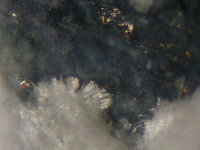 |  |  |  |
Nesquehonite: infinite chains along [010], formed by corner-sharing MgO6 octahedra. Within the chains, CO3 groups link three MgO6 octahedra by two common corners and one edge, which causes strong distortions of the involved polyhedra. The chains are interconnected via hydrogen bonds only, each Mg atom is coordinated by two H2O ligands, and one free water molecule is situated between the chains (Giester et al., 2000, Mineralogy and Petrology 70, 153-163).
Natron: pairs of edge-sharing Na(H2O)6 octahedra forming Na2(H2O)10 units, and CO3 molecules. These units are connected by hydrogen bonds. Carbonate groups show a certain disorder at room temperature (Libowitzky & Giester, 2003, Mineralogy and Petrology 77, 177-195).
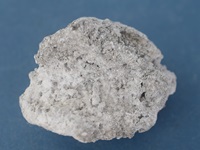 |  |  |
Baylissite: Mg in octahedral coordination, K in 7-fold coordination.
Chalconatronite: Na in octahedral coordination, Cu in 5-fold, square pyramidal coordination (Mosset et al., 1978, Z. Krist. 148, 165-177).
Trona: Na in octahedral and 6-fold irregular (septahedral) coordination, forming groups of one central octahedra and two septahedra by edge-sharing. The groups are connected via carbonate and hydrogen bonding (Bacon & Curry, 1956, Acta Cryst. 9, 82-85).
Gaylussite: Na in distorted octahedral coordination, Ca in 4-fold coordination with distances < 3 Å and 2 oxygen in larger distance (Dickens & Brown, 1967, Nat. Bureau of Standards Report 9921).
Pirssonite: Na in distorted octahedral coordination, Ca in 8-fold, square anti-prism coordination (Corazza & Sabelli, 1967, Acta Cryst. 23, 763-766).
Shomiokite-(Y): Na in heavy distorted octahedral coordination, Y in 9-fold coordination (Rastsvetaeva et al., 1997, Eur. J. Min. 8, 1249-1256).
Lecoqite-(Y): Na in heavy distorted octahedral coordination, Y in 9-fold coordination (Pekov et al., 2010, Can. Min. 48, 95-104). Lecoqite-(Y) shows some structural relations to Shomiokite-(Y), both minerals contain similar sodium carbonate layers.
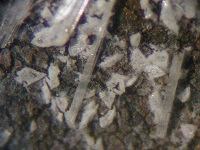 | 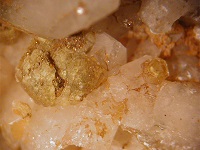 | 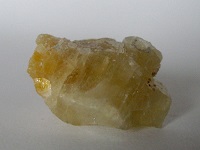 | 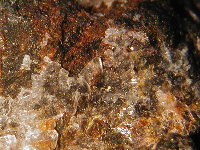 |
Monohydrocalcite: Ca in 8-fold coordination. CO3 groups show a disorder, pointing up or down the c axis. C-O distances of 1.251 and 1.273 Å and one extraordinary long distance of 1.367 Å indicate that hydrogen is bonded to it, forming a HCO3 anion. The formula can then be written as CaHCO3(OH) (Kohatsu & McCauley, 2019, Army Research Laboratory TR-8644).
Ikaite: Ca in 8-fold coordination, 2 to oxygen from carbonate groups and 6 to oxygen from water (Lennie et al., 2004, Min. Mag. 68, 135-146).
Yuchuanite-(Y): Y in 8-fold coordination.
Tengerite-(Y): Y in 9-fold coordination. Sheet structure of YO9 polyhedra and planar CO3 groups. The layers are connected by other CO3 groups to a 3-dimensional network (Miyawaki et al. 1993, Am. Min. 78, 425-432).
Kimuraite-(Y): Related to the Tengerite-(Y) structure. Tengerite-like corrugated layers of YO9 polyhedra and planar CO3 groups, alternating with a layers of Ca cations and water (Tahara et al., 2003, Abstr. Meeting Min. Soc. Japan).
Lokkaite-(Y): Related to the Tengerite-(Y) structure. A pair of Tengerite-like corrugated layers of YO9 polyhedra and planar CO3 groups, alternating with a layers of Ca cations and water (Tahara et al., 2003, Abstr. Meeting Min. Soc. Japan).
Hizenite-(Y): Alternating blocks of Lokkaite-(Y) and Kimuraite-(Y) structures in 1 : 1 ratio, stacked along c (Takai & Uehara, 2013, J. Min. Petr. Sci. 108, 161-165).
Calkinsite-(Ce): probably structurally closely related to the minerals of the Lanthanite group, with very similar a and c parameters, but smaller b parameter.
Lanthanite: REE in 10-fold coordination. The structure is composed of infinite sheets of REEO10-polyhedra and carbonate triangles, stacked perpendicular to c. The layers are connected through hydrogen bonding via interlayer water molecules (Morrison et al., 2013, Acta Cryst. E 69, i15-i16).
Thermomatrite: Na (1) in irregular 5 + 1 coordination (5 oxygen from carbonate groups, 1 oxygen from water in larger distance), Na (2) in irregular 7-fold coordination (Dickens et al., 1970, J. of Research of the Nat. Bureau of Standards 74A, 319-324).
Adamsite-(Y): Na in irregular coordination with 6 oxygen from water, Y in 9-fold coordination (7 oxygen from carbonate groups, 2 oxygen from water) (Grice et al., 2000, Can. Min. 38, 1457-1466).
Donnayite-(Y): Na and Ca in irregular 6-fold coordination, Y in 9-fold coordination, Sr in 10-fold coordination (Lykova et al., 2023, Eur. J. Min. 35, 133-142). Mckelveyite-(Y) polytypes: Mckelveyite-(Y)-1A (tric, P1), Mckelveyite-(Y)-2M (mon., Cc, originally accepted as a new mineral, IMA 2005-012a, but later withdrawn).
Galgenbergite-(Ce): Ca in 8-fold, Ce in 10-fold coordination.
Tuliokite: Na in 8-fold coordination, Ba and Th in 12-fold icosahedral coordination (Yamnova et al., 1990, Dokl. Akad. Nauk SSSR 310, 99-102).
 |  |  |  |
G = Grandfathered minerals: original description preceded the establishment of the CNMNC in 1959, and generally regarded as a valid species
A or IMA No. = Minerals approved by the CNMNC
Rd = Redefinition of the mineral approved by the CNMNC
Rn = Renamed with approval by the CNMNC
Q = Questionable mineral
Classification principles:
Subdivision of the Carbonates subclass "5.C: Carbonates without additional anions, with water" completely re-arranged compared to the chemical classification in Strunz 9. The subdivision is based now on structural aspects, the coordination polyhedra, corresponding roughly to the cation size (from smaller to larger cations): 5.CA. With cations only in tetrahedral coordination; 4.CB. With cations in tetrahedral + other coordination; 5.CC. With cations only in octahedral coordination; 5.CD. With cations in octahedral + other coordination; 5.CE. With cations in other coordination.
Further classification:
|
5.CA. With cations only in tetrahedral coordination: No example known at time. 5.CB. With cations in tetrahedral + other coordination: Only one mineral. 5.CC. With cations only in octahedral coordination: Mainly medium-sized cations in octahedral coordination; large cations in octahedral coordination. 5.CD. With cations in octahedral + other coordination: Medium-sized cations in octahedral + other cations in other coordination sorted according to increasing coordination number; large cations in octahedral + other cations in other coordination. 5.CE. With cations in other coordination: Single coordination type, arranged with increasing coordination number; more than one coordination type, arranged with increasing coordination number (with few exceptions to show structural relations). |
To distinguish from classical Strunz numbering, on hierarchical "group" level, a numbering with 3 digits is used, like "5.CB.005. Paulišite", instead of 2 digits (like "5.CB.05.") in the Strunz system.
© Thomas Witzke (2023)
